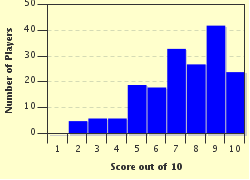Quiz Answer Key and Fun Facts
1. How did Matilda of Flanders meet her future husband, William, for the first time?
2. How did Emma of Normandy respond to Canute's marriage proposal?
3. How often is it believed that the bride of Richard I, Berengaria of Navarre, visited England when they were married?
4. How was Ealhswith chosen to be the Queen of Alfred the Great?
5. How did Jane Seymour, the third wife of Henry VIII, die?
6. How was the coronation of King Richard III and Anne Neville unique?
7. How did Isabella of France earn the infamous title, "She-wolf of France"?
8. How did Mary of Teck gain the respect of the British people during WWI?
9. How did Philip become the Duke of Edinburgh in 1947?
10. How well was the wife of Charles I, Henrietta Maria of France, admired in England after their marriage?
Source: Author
ponycargirl
This quiz was reviewed by FunTrivia editor
bloomsby before going online.
Any errors found in FunTrivia content are routinely corrected through our feedback system.

